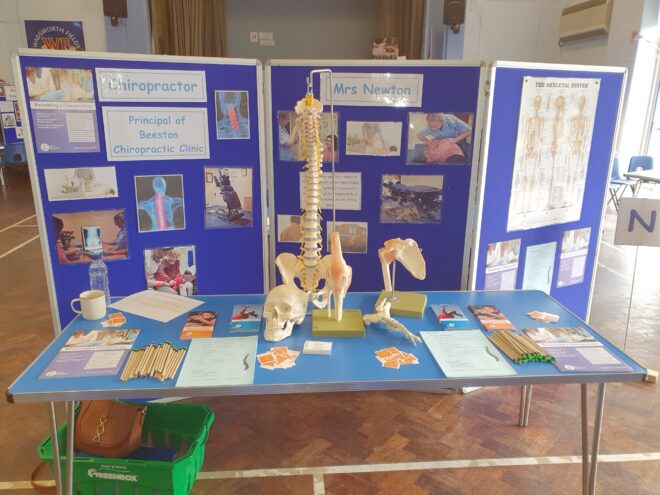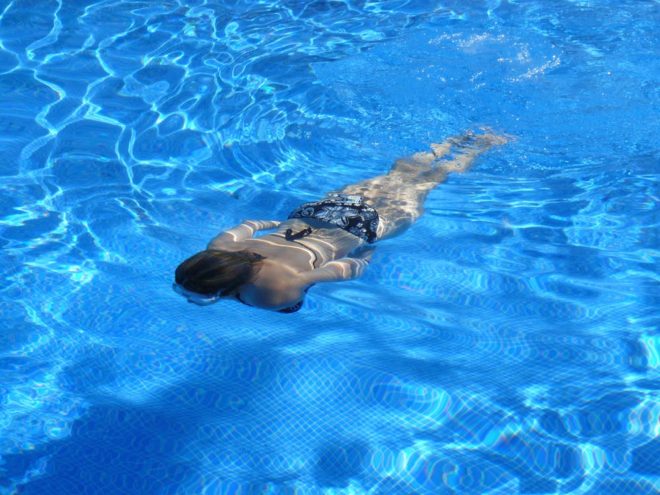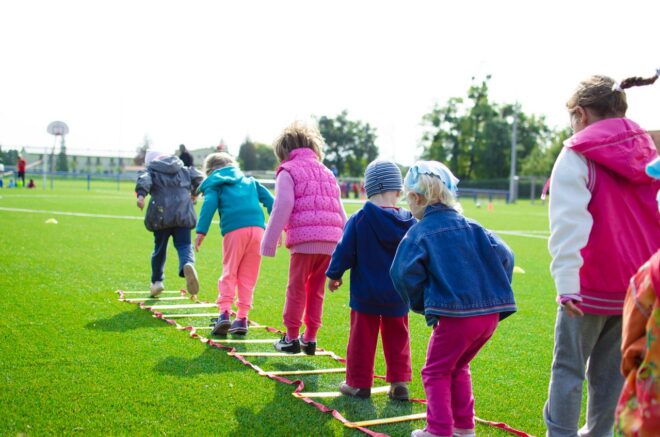
Clinic News
Our focus this month is on the younger generation. School holidays are around the corner and a great time to get them checked out while school is out. Look out this month about the benefits of chiropractic care for the younger population. Did you know Alex has a Masters degree in Paediatric Musculoskeletal health? Children are not small adults and therefore the techniques and procedures used to realign their spines are different to adults. Performed by experienced chiropractors the treatment is safe and the children love it.
To top this Alex was invited to join a careers day at Wadsworth school talking to 180 year 5 &6 pupils about the prospects of being a chiropractor when they leave school. There were some real characters, full of enthusiasm and charisma and it was a challenge to engage with them. They loved the models of the spine, skull and other body parts and were amazed at how their bodies looked inside. We definitely think we could see a couple of them joining the profession in the not-too-distant future.
Andrea and Alex are doing a sterling job looking after the extra patients - it's been lovely to touch base with many who we have not seen for a number of years and meet new patients. It is a privilege to support you through your chiropractic journey.
Our craft stall showcase has come to an end now. Thank you to everyone who supported these lovely micro businesses. The proprietors we very pleased with the support and the ability to advertise their products. We will be running a similar event in November/December so if you have a business you would like to advertise please let reception know.
Our tree fund is coming along nicely - a grand total of: over £1200 is now in the kitty.
The swimmers are totalling up the mileage nicely- well done to Sue, Marianne, Amanda, Glenys, Sophie, Kevin, Kelly and the Scott family- you are all amazing - keep going we are nearly halfway there but still plenty of time to get those lengths in.
We had an extra visit from Luke last week - he's chomping at the bit to join the team at the end of the month. He is working very hard still behind the scenes to understand the running of the clinic so he can hit the floor running in a few weeks. Andrea and Alex certainly will be grateful for him starting to share the load.

Summer Health
Warmer and longer days in the summer can cause to relax into a ‘school’s out’ attitude, where you can experience a drop in your energy levels. Or you could be having so much fun in the sun that you forget to take care of yourself. Either way the willpower to engage in practices vital for a healthy lifestyle gets pushed to the back of your mind.
With summer comes the possibility of health issues such as dehydration, heat stroke, tiredness, upset stomach and bacterial infections. Make sure you’re on track for a happy and healthy summer with these six wellness practices that allow you to enjoy a season full of fun.
- Make Sure You’re Hydrated
Properly hydrating is important any time of the year, but in the summer heat our bodies lose water at a rapid rate. It is essential to replenish the lost water in order to stay hydrated. Aim to drink about two-thirds of your body weight in kilos, in ounces of water each day, eg if you are 60kgs in weight then you should drink around 60 ounces (around four pints) of water a day.
- Add More Fruits and Veggies to Your Diet
Eating fruit and vegetables every day will benefit your overall summer health as they’re rich in fiber, minerals, antioxidants, vitamins and other heart-healthy agents.
Try out berries, watermelon, cucumber, mangoes, sweet corn, celery, oranges and plums as each is in season.
- Eat Lighter
Did you know that your stomach takes longer to digest foods when the weather is hotter?
Try not to consume too much food this summer by opting for lighter meals/portions and snacks (especially at night).
- Get Your Vitamin D
Vitamin D is one of the most common nutrient deficiencies in modern society for reasons like sunscreen and our indoor lifestyles.
Vitamin D is an essential nutrient needed to support your bodily functions — from bone health to your immune system to your mood. Though most of the nutrients our body needs are available via the food we eat, vitamin D is primarily acquired via sun exposure.
- Be Good to Your Eyes
To protect your vision at work and at play, wear protective sunglasses to block your eyes from the harsh rays of the sun. When outdoors, wear sunglasses that block at least 99% of ultraviolet A and B rays.
- Develop an Exercise Routine
The warmer summer months are a great time to start a new exercise routine. Try swimming, walking, hiking, cycling, jogging and other outdoor activities this summer! This will help keep your body and mind aligned.
Practice these six tips for a happier and healthier summer!

Swim for Your Health
Floating, front crawl, butterfly, backstroke, breaststroke or freestyle – no matter how you get around in the water, swimming is the perfect cardio workout. The benefits of swimming are vast and regular pool attendance can improve your overall health.
Here are 6 amazing benefits of swimming:
- It’s a full-body workout
One of the major benefits of swimming is that when you jump into the pool, you work your entire body. You may think it’s only your arms and legs being worked, but that’s not the case. Swimming increases your heart rate without stressing your body, tones muscle, builds strength, builds endurance and engages almost all of your back muscles.
30 minutes in a pool is worth 45 minutes of activity of similar intensity on land.
- It’s easy on your joints
Another benefit of swimming is that water supports up to 90 percent of the body’s weight. Your joints only have to deal with 10 percent of their usual weight load, which lowers your chance of injury. So, if you have mobility issues with land-based exercise, you may still be able to swim to stay active. You can perform a high intensity swimming workout to get your heart rate up or perform a relaxed routine if that’s more your vibe. Either way, it’s unlikely to aggravate your joints and will help your overall health.
This makes swimming a great option for people of all ages and skill levels.
- It burns up calories
Since swimming is a full body workout, it is one of the most effective ways to burn calories! Swimming at a relaxed pace burns around 200 calories in just half an hour (the same amount of calories as jogging without the joint stress). And if you are a faster swimmer, you would burn even more!
- You can swim every day
Many people swim everyday seeing that it is gentle enough on the body that you can swim at a reasonably high intensity (heart rate-wise) every day without risking injury. Of course, rest days are always recommended.
- It improves your mental health
We can all agree that life gets hard and stressful, swimming regularly can reduce anxiety and depression and lower your stress levels. When swimming, it’s just you and the water; the outside world is left outside the pool. You can’t scroll on Instagram, respond to business emails, or whatever you do in your digital time, so your brain naturally switches away from these. Swimming forces you to power down from constant digital stimulation and relax your mind.
- It helps you get better sleep
Swimming has been linked to improved sleep duration and better sleep quality. We need sleep to allow our body and brain to recharge for the days ahead of us. Plenty of sleep also helps your body remain healthy and fight off diseases. When swimming regularly, plus good sleep time, you can improve your quality of life and mood.
Remember, regular swimming will improve both your health and outlook!

Growing pains
Growing pains can go hand-in-hand with growing up, and they are something that many children experience. Although they are harmless, they can be very painful.
Who gets growing pains?
Growing pains are usually experienced by children in primary school, with experts suggesting the pains stop by the age of 12. Whilst the cause of the pain is unknown, growing pains are thought to be more common in active children and children with flexible joints.
How long to growing pains last?
There is little evidence to suggest that growing pains are only associated with growth spurts. In fact, they can be experienced over months or even years.1
What do growing pains feel like?
Understanding the child’s pain can be tricky if you didn’t experience growing pains, or if you’ve forgotten the sensation.
Growing pains mainly affect the legs and, importantly, the pain is experienced in the muscles rather than the joints. It is a throbbing or aching feeling that frequently occurs in the evening and during the night. Though it should go away by the morning, it can sometimes disrupt a child’s sleep.
Treating growing pains
There is no specific treatment for growing pains, but there are a few ways to make a child more comfortable and ease the pain. For example:
- Gently massaging your child’s legs
- Use hot water bottles or heat packs on the painful area
- Run them a warm bath before bed
- Ensure they are wearing supportive shoes throughout the day, or uses orthotics if required
- Encourage the child to stretch
- An age-appropriate anti-inflammatory medication

A Parents’ Guide to Safeguard Kids Spinal Health
Every parent wants the best for their child, especially when it comes to health. Children go through developing stages and each one has an impact on their bones and spine, from the first lost tooth to the last sport injury. It’s important to check in with kids about how their back feels and get a check-up if they think that something doesn’t feel right. Just like going to the dentist for a check-up, a chiropractor will check your child’s spine for any misalignment or imbalance, and the aim is to restore the child’s natural posture and health.
There are ways to prevent children from experiencing back pain during their developing years, and it all starts with being physically active and how they carry their school rucksack. Here are four tips to safeguard your child’s spine:
- BAG IT LIGHT: school bags are often filled with more than what a child really needs. Backpacks are the best bags because they spread the weight evenly on each shoulder. Try to keep the backpack to a light/medium weight, filling it only with what is required. Remember to adjust the straps so that the bag so that weight is evenly distributed and the child’s spine doesn’t have to compensate.
- WALK ON AIR: supportive footwear is essential to maintain a healthy posture. Soft-soled shoes that have good inner arch support will keep the kid happy and balanced. It is worth considering replacing the insole that comes with the shoe (which are normally of low quality) with a soft supportive insole. This will usually make a difference to the aches and pains that a child may feel late in the day after being on their feet for most of it.
- EXERCISE: 21st century kids tend to spend more time in front of a screen compared to older generations, lowering the time spent being physically active. It would be ideal to set aside the same time that a child spends sitting in front of a screen, to time being physically active. Dance or run breaks are great family activities.
- GAMING POSTURE: Videogames tend to distract your kid from maintaining a comfortable posture while playing. If your kid is playing with videogames make sure their spine is supported while doing it.

Healthy Postural Positions for Babies
Birth is one of the most traumatic experiences a baby can go through. It is not often known, for example, that the baby’s cranial bones move and overlap affording the flexibility required during delivery. Even after a successful delivery, a baby’s spine is still at risk.
However, there are some precautions you can take as a parent to minimize this risk both to your baby and to yourselves. Here are the healthiest positions for you to care for your baby.
Holding baby: your baby should be held close to you with the back of your baby’s head supported with your index finger behind the ear.
Bathing baby: your baby’s head should be supported using your thumb and forefinger while your free hand is used for bathing and supporting your baby in the tub.
Parent/child interaction: throwing your child up and down can actually cause spinal problems due to a lack of support as your child is being bent forward and backwards.
Picking children up: when lifting your child, you should be on your haunches, lift your child while holding them under both arms, and avoid carrying them on one hip. Preferably, your child should be carried in front of you with one leg either side of you.
Papoose type slings and carriers: unfortunately contraptions that allow your child to sit before it is naturally able to can cause major spinal problems. Most of the holding devices keep your baby’s spine in the ‘c’ shape curve it’s born with and do not allow the normal curves in the neck and low back to develop.
Dressing the child: clothing that has a tight collar can put a strain on your child’s spine in the neck and the area between the shoulder blades. Buttons and zips should be used as much as possible.
Feeding: if breast feeding, you should hold the baby at the level of the breast whilst supporting your arm on a pillow, to reduce spinal problems in yourself. You should place the baby so that it faces your breast so that rotation of your baby’s neck is minimized.
Crawling: crawling should be actively encouraged, as a lack of sufficient crawling is responsible for weak spinal architecture.
Emotional stress can also affect your baby. Domestic disharmony and maternal distress is very quickly picked up by the infant and translated into irritability, crying and unsettled behaviour. The negative effect on muscle tone, sleeping and feeding patterns is a major contributor to spinal subluxations.
As parents, bonding should be encouraged immediately for you both. Holding the infant close to your body, maintaining sustained eye contact, smiling and making soothing sounds are all important.






